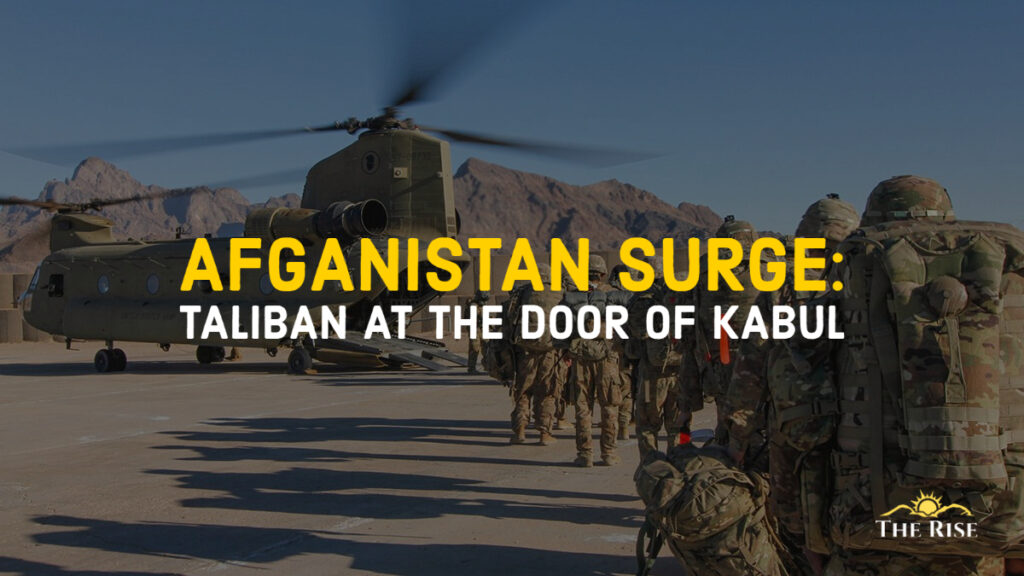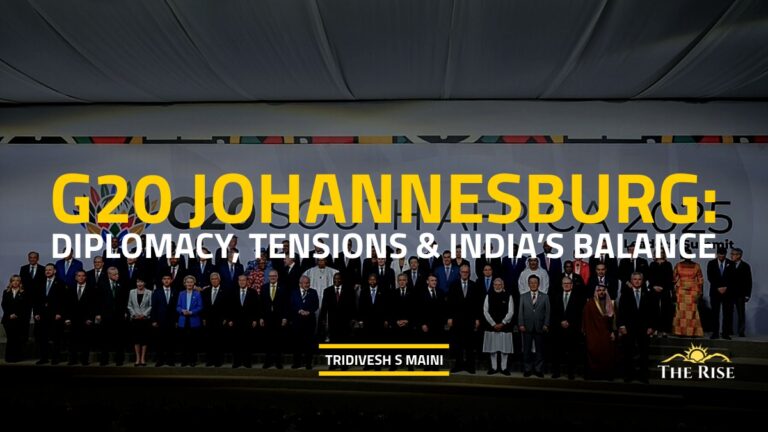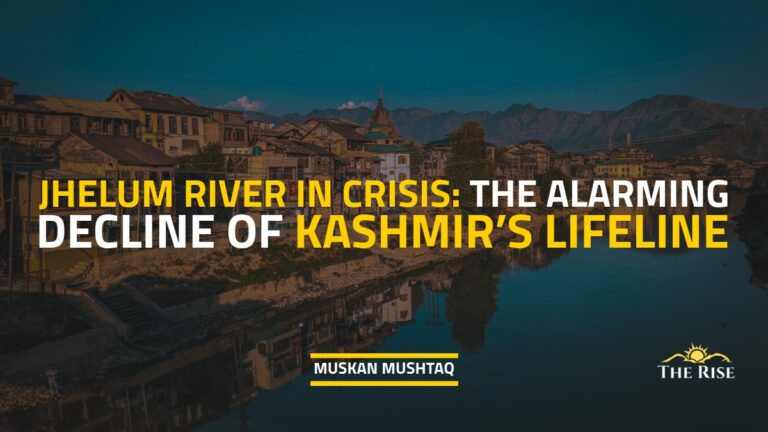On July 2, 2021, Friday, the US forces quietly vacated the Bagram airfield, considered to be the epicentre of its campaign to remove the Taliban and capture the perpetrators of the 9/11 attacks, after nearly two decades. This effectively brings an end to the Afghan ‘forever war’, the longest war fought in US history. As foreign troops retreat, the Taliban forces are sweeping across Afghanistan. The possibility of civil war looms over the country as the region has been pushed into turmoil after the withdrawal of western forces. Twenty years down the line, are we back to square one?
The United States and the Taliban signed a peace deal on February 29, 2020, outlining a schedule for the departure of US troops from Afghanistan. This deal requires the US to decrease its forces to around 8,500 people within 135 days and to completely pull out within 14 months. The Taliban vowed to deny terrorist groups access to their area and to engage in discussions with the Afghan government by March 2020. A ceasefire deal was struck after seven days of severe limitations on the American and Afghan military forces attacking Taliban-controlled regions. Does the present situation resemble the Taliban at the door of Kabul?
Despite this agreement, there is no formal ceasefire. Throughout 2020 and into 2021, combat in Afghanistan remained high as the US escalated airstrikes and raids against the Taliban, while the Taliban continues to assault Afghan government targets, acquire land, and attack ANDSF camps and outposts. Additionally, the Taliban has undertaken high-profile attacks, especially in Kabul.
Background

Following Al-Qaeda strikes, the US invaded Afghanistan in order to capture alleged terrorist Osama bin Laden. Afghanistan and Pakistan saw the Taliban rapidly lose control of the nation and leave. They then fought an insurgency against the Kabul government, coalition soldiers, and Afghan security forces.
The ANDSF is facing many big challenges in defending the population centres and holding territory even eighteen years into the conflict, and five years into its new position as responsible for securing the country.
Current Scenario
Two US officials say the US military has vacated Afghanistan’s Bagram air base, the epicentre of its campaign to remove the Taliban and capture the perpetrators of the 9/11 attacks, after almost two decades. According to the AP, the airstrip was given to the Afghan National Defence and Security Forces completely free of charge.
However, Afghan military officials say that the US slipped away from the Bagram airfield in the night without notifying the new Afgan commander until two hours after they left. “In one night they (Western powers) lost all the goodwill of 20 years by leaving the way they did, in the night, without telling the Afghan soldiers who were outside patrolling the area,” said Afghan soldier Naematullah, who asked that only his one name be used.
The top US commander in Afghanistan, General Austin S Miller, retains all of the powers and authority to protect the soldiers, according to one of the sources. During its peak, more than 100,000 US soldiers travelled through the huge complex 30 miles north of Kabul.
Evacuation from the airfield is the clearest proof that the last of the US soldiers are leaving Afghanistan before President Joe Biden’s stated departure date of September 11, 2021. After 20 years of US aid, Biden expects the Afghan administration and the military to successfully combat the Taliban’s increased activity. “They can keep the government running. Additional talks may be required in the future,” Biden explained. “But I am concerned that they deal with the internal issues that they have to be able to generate the kind of support they need nationwide to maintain the government,” the US President said.
As the US celebrated its Independence Day on July 4, 2021, the complete departure of its soldiers and the expected 7,000 NATO partners would be about two months later. The bulk of European soldiers withdrew with little fanfare, starkly different from the 2001 situation of conspicuous queing up of all NATO allies to support the U.S. invasion.

The US has refused to announce the final of its troops’ departure from Afghanistan, citing security concerns and Karzai International Airport’s continued protection. US and Turkish forces are guarding the airport. US troops will be stationed in Afghanistan to defend the American embassy in Kabul. It is believed that they will be covered by a bilateral agreement with the Afghan government.
The U.S. and NATO’s exit from Afghanistan arrives as Taliban terrorists successfully take control of many areas and overrun the battered Afghan Security Forces. The government has re-established paramilitary groups, with a horrific history of cruelty, to aid Afghan security forces.
India’s Afghanistan Challenge
India has reiterated its commitment to Afghanistan and laid out the ideals it desires to see underpin the peace process. Last week, Mr. Jaishankar delivered a speech to the UN Security Council on the UN Assistance Mission in Afghanistan, where he called for a lasting and comprehensive ceasefire in the war-torn nation to protect civilians and limit bloodshed. He stressed the terrible fact that Afghan negotiations have not led to a reduction in bloodshed and that “the international community, including this Council, must demand a lasting and comprehensive ceasefire to prevent an instant drop in violence and to safeguard civilian lives.”
New Delhi reaffirmed its support for an “inclusive, Afghan-led, Afghan-owned, and Afghan-controlled peace process,” but stated, “no political settlement in Afghanistan could ever include the undoing of the last two decades’ achievements.” India received significant global attention, in particular, for calling for “zero tolerance for terrorism in all its forms and manifestations, including cross-border assaults.”
National Security Advisor Ajit Doval emphasised the necessity of safeguarding Afghan achievements acquired over the last two decades and prioritising the welfare of the Afghan people at an SCO member states’ summit in Tajikistan.
According to India, the only option for Afghanistan to attain long-term peace is for the country to be at peace both internally and externally. Jaishankar pointed to the necessity to “preserve the constitutional democratic framework, and guaranteeing the protection of women, children, and minorities.”

At this vital moment, conversations between the Taliban and the Afghan government have reached a critical point, and realities on the ground are fast shifting. The United States and the Taliban came to an agreement in Doha on February 29, 2020, starting the process of intra-Afghan negotiations. Early this year, the Biden administration said that US soldiers will be entirely withdrawn by September 11, 2021.
The Taliban currently believes this as a turning point and is working hard to consolidate its ground advantage. To expand its new ground rules, the Taliban has targeted government officials, educational facilities, and political opponents. The Taliban took control of Afghanistan’s northernmost border crossing with Tajikistan in Kunduz city, one of the biggest successes of the Taliban since May when the US began to wind down its military operations. Some Afghan soldiers allegedly abandoned their posts and fled to Tajikistan.
Also Read: A New Withdrawal Playbook: US-Afghanistan and Implications for India
It is critical for India to continue to emphasise its own red lines in its contacts with the Taliban, as Jaishankar recently did at the UN. The Taliban’s position as an autonomous political player beyond the sway of Pakistan’s military-intelligence complex will also be determined by how far it is able to engage actors such as India as it pursues a more central role in the Afghan government structure.
Pakistan’s backing for the Taliban cannot secure Afghanistan’s future. If the Taliban are to have some credibility and durability in ruling Afghanistan, India’s position will remain crucial. No one can deny this essential fact.
Disclaimer: The views expressed in this article are of the author solely. TheRise.co.in neither endorses nor is responsible for them.
About the author
Neeraj Singh Manhas is a Director of Research, Indo-Pacific Consortium, at Raisina House, New Delhi. He has authored four books under his name and has various research interests covering India-China in the Indian Ocean, India's maritime securities, and Indo-Pacific studies.










Pingback: Politics and Diplomacy in COVID-19 Pandemic - TheRise.co.in
Pingback: Afghanistan: A new opportunity for Quad - TheRise.co.in
Pingback: United States, NATO, and the Taliban: Analysis of Politics - TheRise.co.in